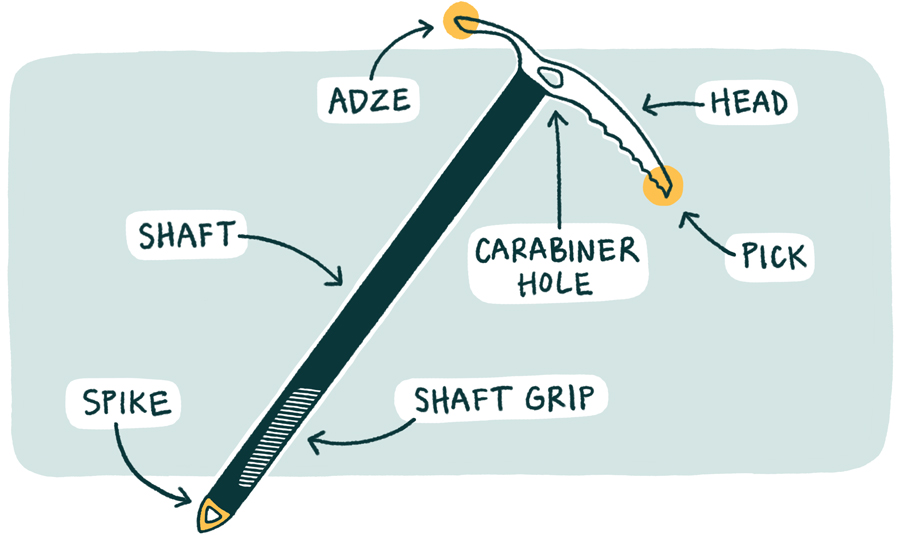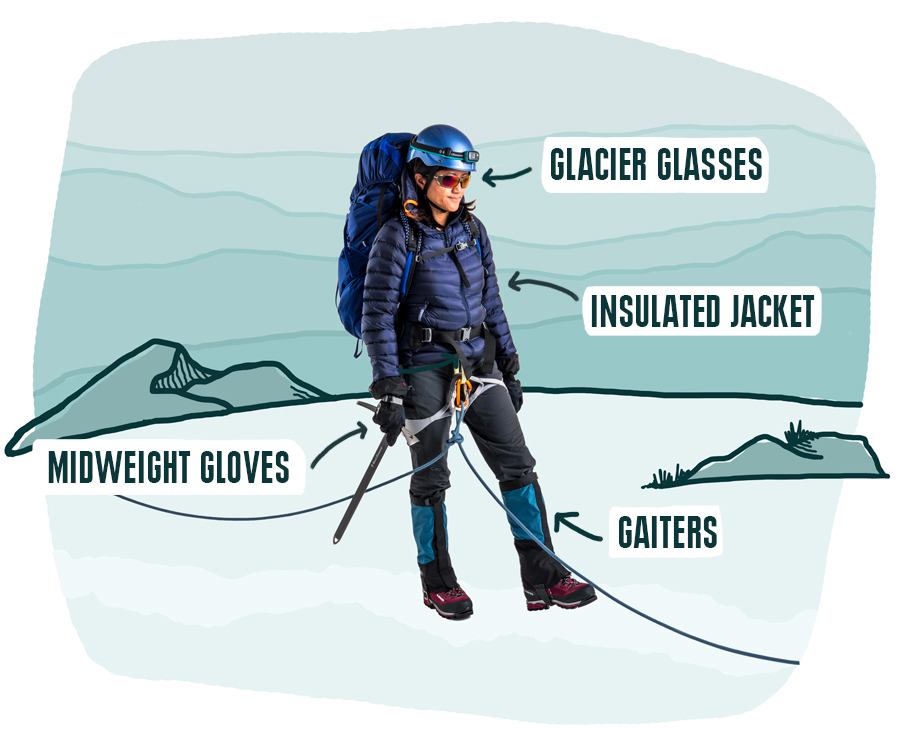Gear talk! Surprise surprise! Turns out there are companies out there other than Patagonia that make quality gear! Having proper training and being in an excellent physical and mental state are crucial to a successful mountaineering experience. However, you also need to equip yourself with appropriate clothing and gear. Mountaineering, to a certain extent, shares a lot of gear with rock climbing.

For example, you will need a harness, rope, locking / non-locking carabiners, quickdraws, camalots and the list goes on. The mountaineering gear that is required depends on the kind of route you are planning to do. For instance, if you will be crossing glaciers, you will need a rope, harness, crevasse rescue equipment and crampons, but if you are spending most of your day ice-climbing and covering long distances on steep terrain, you will also need an ice-axe and ice-screws. Depending on the nature and difficulty of the activity, you might also take into consideration the design and features of the gear as well. The gear list is long and expensive which is why it took us a while to acquire all the gear we need.
If you have been reading these blogs for their entertainment value, it’s about to get a lot juicer. C: Most of you might know Jenny as the president of UNSWOC for 2018 and what an amazing job she did. After only a few weeks of sharing a house with her, I have discovered a side of Jenny that is unknown to most people. She is a gear freak! Yup I said it and I have proof! I might be known as the person with all the gear but no idea but Jenny is not far from behind.
Alright! Enough trash talk, back to gear. Lucky for us, the New Zealand Alpine Club (NZAC) sent us a document detailing the gear we will need for the course.

As you can see, the list is pretty long, so to be fair, Jenny’s compulsive need to shop is not completely unjustified. The first piece of gear we all purchased is probably mountaineering boots.
Mountaineering Boots
A good fitting pair of mountaineering boots will provide traction and stability for travelling on rocky terrain. Different from normal hiking boots, mountaineering boots are designed to be compatible with crampons for ice-climbing and glacier travels. There are two basic choices when purchasing your first pair of mountaineering boots: insulated vs non-insulated.
Double, or insulated mountaineering boots involve an inner thermal liner or ‘bootie’ that fits inside a shell or ‘outer-boot’. They are often a little heavier and bulkier than others. With the extra weight, the insulted design is perfect for high altitude mountaineering since they will keep your toes toasty warm.

Consider double boots if you
- Are climbing above 5000m in good spring weather
- Climbing anything in winter conditions
Single or non-insulated mountaineering boots are for climbs in more mild temperatures. They are typically less bulky and lighter than insulated boots, making them more comfortable and agile. It is common for mountaineers to wear single boots during mid-season climbs.
Crampons
Crampons need to be strong and durable. The spikes bite into ice to improve stability on snow and ice during glacier travel, ascending snow slopes and ice climbing. The type of crampons will need to be fitted to your mountaineering boots. Some crampons are designed for boots with both heel and toe welt, so make sure you know what kind of boots you are getting before purchasing crampons!
Ice Axes
When choosing an ice axe, you will need to consider the design, weight along with your size and activity that you will engage in. For classic mountaineering and scrambling, you will consider an ice-axe with a straight shaft or a slightly curved one if the route involves lots of steep terrain. For ice-climbing, they are generally shorter, with bent shafts and a head that has a different design from a classic ice axe.

Clothes
Enough about hard gear, what about clothes? It is important to stay comfortable while mountaineering. Again what layers you choose and pack for the trip really depends on trip specifics conditions. Like where you are going, what kind of activities you will be doing and what conditions you are likely to encounter. Here are somethings to keep in mind when packing for a mountaineering trip.
- Weather can change quickly: It is important to consider the full range of temperature you will encounter while mountaineering.
- Weight vs. comfort: You don’t want to overpack with lots of extra clothing. Its not a fashion show!
- Functionality: Most outdoor clothing are loaded with features, but try to avoid unnecessary features that may add on weight.
- Fabrics: Cotton takes much longer to dry and is a poor insulator (especially when wet). Choose wool or other synthetic options instead!
- Glacier Glasses: Your normal sunnies might not be good enough for the mountains. Snow and ice has reflective qualities that send more UV rays into your eye. Snow blindness is essentially getting a sunburn on your cornea. Glacier glasses are rated (Category 1 to 4). Make sure you look after your eyes in the mountains!
- Insulated mittens: A pair of warm insulated gloves will drastically improve your experience in the mountains. Bring a spare pair of inner gloves incase the first pair gets wet.

We all do it. We try to justify our spending on gear one way or another. For me, I tell myself to never cheap out on safety, for Jenny, she has a pathological need to spend so I am not too sure what’s her problem is. Whatever it is, the rule of thumb is to conduct a thorough research on your trip, bring gear that is tailed to the kind of activities you are doing and make sure you look after them!
Sources:
- https://www.rei.com/learn/expert-advice/mountaineering-gear-essentials.html
- https://www.rei.com/learn/expert-advice/ice-axe.html
- https://www.rei.com/learn/expert-advice/what-to-wear-mountaineering.html
- https://mountainequipment.com/blogs/mountain-equipment-blog/when-to-double-up-mountaineering-boots-single-or-double
- https://www.ems.com/f/ea-how-to-choose-mountaineering-boots.html

